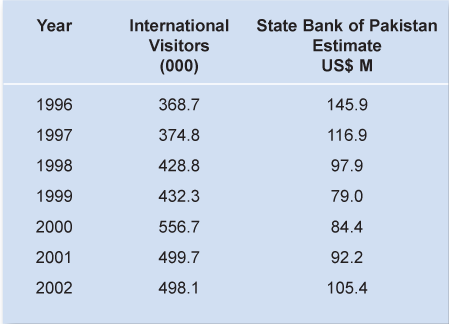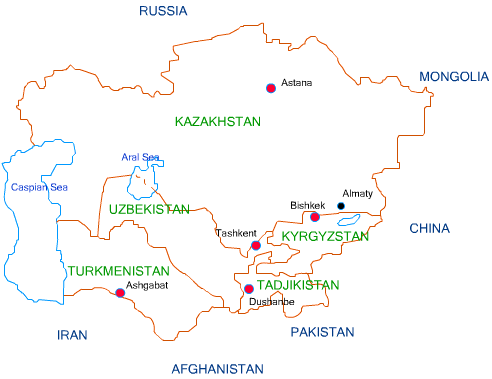Pakistan is ranked 113 out of 130 countries according to the World Economic Forum?s Travel and Tourism Competitiveness Report, 2009. This ranking was made by adding all Afghanis, Bangladeshis, Indians, and overseas Pakistanis who visit Pakistan as tourists. If we talk about pure then Pakistan?s estimated ranking is around 121 out of 130 countries.
Some may say that this low ranking is due to the worsening law and order and security scenario, in the region post 9/11. However, the following data from the Ministry of Tourism indicates that the situation of tourist arrivals was not very good even before 9/11 event.

Pakistan has always depended upon its adventure tourism potentials instead of developing new products ? while countries close-by, including India, Turkey, Iran and all of Central Asia even, keep adding new products like health tourism, religious tourism, adventure tourism, conference and cultural tourism and so on.
A constant decline in South Asian visits could also be indirectly linked with the opening of Central Asia and Eastern Europe as a significant tourism market from 1995-2000. The new tourism destinations here were comparatively cheap, affordable, secure (their crime rates are low compared to India and Pakistan), and of course unpolluted cultural heritage.
Rise of Central Asian Tourism
Kyrgyzstan saw its tourist arrivals grow from a mere 59,000 to 1.5 million arrivals in 2007, an annual increase 14.8 percent. Azerbaijan saw an increase of 8.4 percent. Since the beginning of the 21st century, the countries in this sub-region have taken steps to promote themselves as emerging tourism desti-nations, reports UN ESCAP.
Cultural tourism is one of the largest and fastest growing forms of global tourism and Uzbekistan and other Central Asian countries are leading in cultural tourism products because Russians and locals preserved culture.
The relationship between tourism and culture is very strong and together they have become major drivers of destination attractiveness and competitiveness. My recent travels to Iran, Azerbaijan and Uzbekistan enriched me with a thoroughly well-preserved cultural experience. If you walk through the streets of old Isfahan and Baku; you feel like you are walking in the streets of Bokhara and Samar-kand: same architectural designs, same wooden doors and carving patterns as in all these old cities. These cities have the same cultural texture. The
communities have successfully preserved their cultural heritage, thereby providing a broad base for the development of tourism.
Ties of Linguistics
I enjoyed the atmosphere of camaraderie stemming from people lounging in their balconies which coincidentally sounds the same in Urdu, balkani, and in Russian and Ukrainian, балкон. Our linguistic roots are joyously entwined. I savoured the joys of winter: (the same sounds in Urdu: sarma; Persian: zima; and Russian and Ukranian: зима) with a universally cosy cup of chai, or чай. Languid evenings spent in verandas, (veranda; веранда) remind me of my old Lahore.
But walking through the streets of Lahore today is an experience lost under the dust of commerciali-zation without space in its heard for balconies, verandas or folklore.
How come? What happened to preservation of Lahore?s rich heritage? 70 years of communism and Russian influence did not pollute the society’s
fundamental fabric. With the departure of Russian control ‘Ibrahimov’ (Ибрагимов) again became ‘Ibrahim’ (Ибрагим) and Оксана is now again ?Rukhsana? (Рухсана).
While the Russian imposed Cyrillic script and alphabet are in use, Persian and Turkish vocabulary remain with the Uzbek, Tajik, Kazaki people. The Russian government did not change the names of streets, areas, monuments. When Central Asia was behind the Iron Curtain of Communism there was a misconception that communist rulers banned religion, demolished mosques and erased Islamic monuments. However, buildings were preserved – not on religious grounds but on the grounds of the ‘preservation of culture’. For instance, the Mausoleum of Mir Sayyed Bahram was burnt and then restored impeccably around 1932. Similarly, one can see Islamic culture, monuments and mosques in perfect condition in Bokhara, Samarkand, Tashkent, Khiva, Marve and Ashkabad. The names of roads are mostly after Muslims heroes of the likes of Taimur, Aziz Mirzo, Babur etc.
Muslim-run Eco-lodge B&B
Such a context is more conducive to realizing the positive social impacts of tourism. In Bokhara I had the opportunity to stay with a Muslim family-run Bed and Breakfast ecotourism lodge. This was the ideal eco-lodge: handling small scale tourism, providing direct benefits to the host community. The concept of small scale tourism and eco-lodges is popular all over Central Asia. I found at least three more eco-lodges on the same street where I was staying: an elderly couple was running one lodge with the wife as caretaker and hostess and husband as cab driver.
This family was the perfect small unit of the kind of business the ecotourism concept embodies. Their only daughter was your tourist guide. The husband, Azizov, now calls himself Aziz Beg.
Pakistan, however, seems to be a country where cultural preservation takes a far back seat. Road names are routinely changes under pretexts ranging from Islamization to pleasing the self-propped leaders. Krishan Nagar is now Islampura; Victoria Road is Zaibunissa Street.
Why can we not channel our energy to more constructive ends? What are those who?ve taken the preservation in various ministries and offices doing to promote a deeper appreciation of all the various influences that make Pakistanis who they are today? Let us ask ourselves a question: “Do we respect Jan, Raja Shahi, Hindu or British Cultural monuments and care for them?”
The answer, I think, is a meagre, sheepish smile.







Super article and eye opening. Appreciate this writer